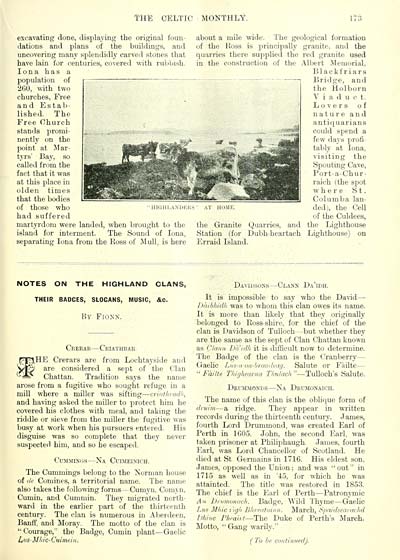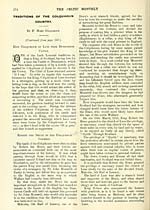Blair Collection > Celtic monthly > Volume 4, 1896
(247)
Download files
Complete book:
Individual page:
Thumbnail gallery: Grid view | List view

THE CELTIC MONTHLY.
1^3
excavating done, displaving the original fouu-
ilations and plans of the buildings, and
uncovering many splendidly carved stones that
have lain for centuries, covered with rubbish.
Ion a has a
population of
2G0, with two
churches, Free
and Estab-
lished. The
Free Church
stands promi-
nently on the
point at Mar-
tyrs' Bay, so
called from the
fact that it was
at this place in
olden times
that the bodies
of those who
had suffered
martyrdom were landed, when brought to the
island for interment. The Sound of lona,
separating lona from the Ross of Mull, is here
■HIGH1,.\N"L)E1;
about a mile wide. The geological formation
of the Ross is jJi'incipally granite, and the
quarries there supplied the red granite used
in the construction of the Albert Memorial,
Black friars
Bridge, and
the Holborn
Viaduct.
Lovers of
nature and
antiquarians
could spend a
few days profi-
tably at lona,
visiting the
Spouting Cave,
Port-a-Chur-
raich (the spot
where St.
Columba lau-
ded), the Cell
of the Culdees,
the Granite Quarries, and the Lighthouse
Station (for Dubh-heartach Lighthouse) on
Erraid Island.
notes on the highland clans,
their badges, slogans, music, &c.
By Fionn.
Ceeeae — Ceiathbar.
IHF^I.HE Crerars are from Lochtayside and
Xl^ are considered a sept of the Clan
^■^ Chattan. Tradition says the name
arose from a fugitive who sought refuge in a
mill where a miller was sifting — oint/nadii,
and having asked the miller to protect him he
covered his clothes with meal, and taking the
riddle or sieve from the miller the fugitive was
busy at work when his pursuers entered. His
disguise was so complete that they never
suspected him, and so he escaped.
CtTMMrSaS Xa CmilEINlCH.
The Cummings belong to the Norman house
of (If Comines, a territorial name. The name
also takes the following forms — Cumyu, Com^n,
Cumin, and Cummin. They migrated north-
ward in the earlier part of the thirteenth
century. The clan is numerous in Aberdeen,
Banfi', and Moray. The motto of the clan is
" Courage," the Badge, Cumin plant — Gaelic
liUS-MJtic-Cuimeiii.
Davidsons — Clann Da'idh.
It is impossible to say who the David^
Doibhidh was to whom this clan owes its name.
It is more than likely that they originally
belonged to Rossshire, for the chief of the
elan is Davidson of TuUoch — but whether they
are the same as the sept of Clan Chattan known
as Clann Dit'idli it is difficult now to determine.
The Badge of the clan is the Cranberry —
Gaehc Lus-n-im-braoi/emj. Salute or Fuilte —
" Faille TIngheavna Tlmlach " — Tulloch's Salute.
Deiiimonds — Na Deumonaich.
The name of this clan is the oblique form of
dniim — a ridge. They appear in written
records during the thirteenth centui-y. James,
fourth Lord Drummond, was created Earl of
Perth in 1605. John, the second Earl, was
taken prisoner at Philiphaugh. James, fourth
Earl, was Lord Chancellor of Scotland. He
died at St Germains in 1716. His eldest son,
James, opposed the Union; and was "out" in
1715 as well as in '45, for which he was
attainted. The title was restored in 1853.
The chief is the Earl of Perth — Patronymic
All. DnimoiHich. Badge, Wild Thyme — Gaelic
Liis Mliic ) 'igti Bliveatuiini. March, Spnidsearachd
Dhivc Phmht — The Duke of Perth's March.
Motto, " Gang warily."
( To be contiunedj.
1^3
excavating done, displaving the original fouu-
ilations and plans of the buildings, and
uncovering many splendidly carved stones that
have lain for centuries, covered with rubbish.
Ion a has a
population of
2G0, with two
churches, Free
and Estab-
lished. The
Free Church
stands promi-
nently on the
point at Mar-
tyrs' Bay, so
called from the
fact that it was
at this place in
olden times
that the bodies
of those who
had suffered
martyrdom were landed, when brought to the
island for interment. The Sound of lona,
separating lona from the Ross of Mull, is here
■HIGH1,.\N"L)E1;
about a mile wide. The geological formation
of the Ross is jJi'incipally granite, and the
quarries there supplied the red granite used
in the construction of the Albert Memorial,
Black friars
Bridge, and
the Holborn
Viaduct.
Lovers of
nature and
antiquarians
could spend a
few days profi-
tably at lona,
visiting the
Spouting Cave,
Port-a-Chur-
raich (the spot
where St.
Columba lau-
ded), the Cell
of the Culdees,
the Granite Quarries, and the Lighthouse
Station (for Dubh-heartach Lighthouse) on
Erraid Island.
notes on the highland clans,
their badges, slogans, music, &c.
By Fionn.
Ceeeae — Ceiathbar.
IHF^I.HE Crerars are from Lochtayside and
Xl^ are considered a sept of the Clan
^■^ Chattan. Tradition says the name
arose from a fugitive who sought refuge in a
mill where a miller was sifting — oint/nadii,
and having asked the miller to protect him he
covered his clothes with meal, and taking the
riddle or sieve from the miller the fugitive was
busy at work when his pursuers entered. His
disguise was so complete that they never
suspected him, and so he escaped.
CtTMMrSaS Xa CmilEINlCH.
The Cummings belong to the Norman house
of (If Comines, a territorial name. The name
also takes the following forms — Cumyu, Com^n,
Cumin, and Cummin. They migrated north-
ward in the earlier part of the thirteenth
century. The clan is numerous in Aberdeen,
Banfi', and Moray. The motto of the clan is
" Courage," the Badge, Cumin plant — Gaelic
liUS-MJtic-Cuimeiii.
Davidsons — Clann Da'idh.
It is impossible to say who the David^
Doibhidh was to whom this clan owes its name.
It is more than likely that they originally
belonged to Rossshire, for the chief of the
elan is Davidson of TuUoch — but whether they
are the same as the sept of Clan Chattan known
as Clann Dit'idli it is difficult now to determine.
The Badge of the clan is the Cranberry —
Gaehc Lus-n-im-braoi/emj. Salute or Fuilte —
" Faille TIngheavna Tlmlach " — Tulloch's Salute.
Deiiimonds — Na Deumonaich.
The name of this clan is the oblique form of
dniim — a ridge. They appear in written
records during the thirteenth centui-y. James,
fourth Lord Drummond, was created Earl of
Perth in 1605. John, the second Earl, was
taken prisoner at Philiphaugh. James, fourth
Earl, was Lord Chancellor of Scotland. He
died at St Germains in 1716. His eldest son,
James, opposed the Union; and was "out" in
1715 as well as in '45, for which he was
attainted. The title was restored in 1853.
The chief is the Earl of Perth — Patronymic
All. DnimoiHich. Badge, Wild Thyme — Gaelic
Liis Mliic ) 'igti Bliveatuiini. March, Spnidsearachd
Dhivc Phmht — The Duke of Perth's March.
Motto, " Gang warily."
( To be contiunedj.
Set display mode to: Large image | Transcription
Images and transcriptions on this page, including medium image downloads, may be used under the Creative Commons Attribution 4.0 International Licence unless otherwise stated. ![]()
| Early Gaelic Book Collections > Blair Collection > Celtic monthly > Volume 4, 1896 > (247) |
|---|
| Permanent URL | https://digital.nls.uk/75849966 |
|---|
| Shelfmark | Blair.56 |
|---|---|
| Additional NLS resources: | |
| Attribution and copyright: |
|
| Description | A selection of books from a collection of more than 500 titles, mostly on religious and literary topics. Also includes some material dealing with other Celtic languages and societies. Collection created towards the end of the 19th century by Lady Evelyn Stewart Murray. |
|---|
| Description | Selected items from five 'Special and Named Printed Collections'. Includes books in Gaelic and other Celtic languages, works about the Gaels, their languages, literature, culture and history. |
|---|

